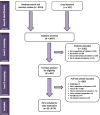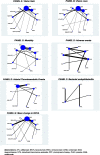Anti-vascular endothelial growth factor therapy for age-related macular degeneration: a systematic review and network meta-analysis
- PMID: 34930439
- PMCID: PMC8690960
- DOI: 10.1186/s13643-021-01864-6
Anti-vascular endothelial growth factor therapy for age-related macular degeneration: a systematic review and network meta-analysis
Abstract
Background: The comparative safety and efficacy between anti-vascular endothelial growth factor agents (anti-VEGFs) and between combined therapies for patients with neovascular age-related macular degeneration (nAMD) is unclear. We conducted a systematic review to examine the comparative safety and efficacy anti-VEGFs for adults with nAMD.
Methods: Studies were identified through MEDLINE, EMBASE, and Cochrane CENTRAL (inception to June 3, 2019), grey literature, and scanning reference lists. Two reviewers independently screened citations and full-text articles to identify randomized controlled trials (RCTs), extracted data, and appraised risk of bias. Pairwise random-effects meta-analysis and Bayesian network meta-analysis (NMA) were conducted. The primary outcomes were the proportion of patients experiencing moderate vision gain (≥ 15 letters on the Early Treatment Diabetic Retinopathy Study chart) and the proportion of patients experiencing moderate vision loss (≤ 15 letters).
Results: After screening 3647 citations and 485 potentially relevant full-text articles, 92 RCTs with 24,717 patients were included. NMA (34 RCTs, 8809 patients, 12 treatments) showed small differences among anti-VEGFs in improving the proportion of patients with moderate vision gain, with the largest for conbercept versus broluczumab (OR 0.15, 95% CrI: 0.05-0.56), conbercept versus ranibizumab (OR 0.17, 95% CrI: 0.05-0.59), conbercept versus aflibercept (OR 0.19, 95% CrI: 0.06-0.65), and conbercept versus bevacizumab (OR 0.2, 95% CrI: 0.06-0.69). In NMA (36 RCTs, 9081 patients, 13 treatments) for the proportion of patients with moderate vision loss, small differences were observed among anti-VEGFs, with the largest being for conbercept versus aflibercept (OR 0.24, 95% CrI: 0-4.29), conbercept versus brolucizumab (OR 0.24, 95% CrI: 0-4.71), conbercept versus bevacizumab (OR 0.26, 95% CrI: 0-4.65), and conbercept versus ranibizumab (OR 0.27, 95% CrI: 0-4.67).
Conclusion: The only observed differences were that ranibizumab, bevacizumab, aflibercept, and brolucizumab were statistically superior to conbercept in terms of the proportion of patients with nAMD who experienced moderate vision gain. However, this finding is based on indirect evidence through one small trial comparing conbercept with placebo. This does not account for drug-specific differences when assessing anatomic and functional treatment efficacy in variable dosing regimens.
Systematic review registration: PROSPERO registration number CRD42015022041.
Keywords: Aflibercept; Age-related macular degeneration; Anti-vascular endothelial growth factor; Bevacizumab; Brolucizumab; Conbercept; Ranibizumab.
© 2021. The Author(s).
Conflict of interest statement
Drs. Andrea Tricco and Areti Angeliki Veroniki are associate editors for the journal and are not involved with the decision or peer-review process. All other authors have no known conflicts of interest to declare.
Figures



References
Publication types
MeSH terms
Substances
Grants and funding
LinkOut - more resources
Full Text Sources
Medical

